2018 Volume Issue 1
Economic Newsletter for the New Millennium
March 13, 2018
For a downloadable version, click the following:
…a bit more compressed version of the PDF
Employment Expansion - here come the jobs!
In the month of February, the Employment in the Current Population Survey grew by 785,000 (largest gain since September 2017); the Nonfarm payroll grew by 313,000, the largest one month gain since July 2016 (325,000).

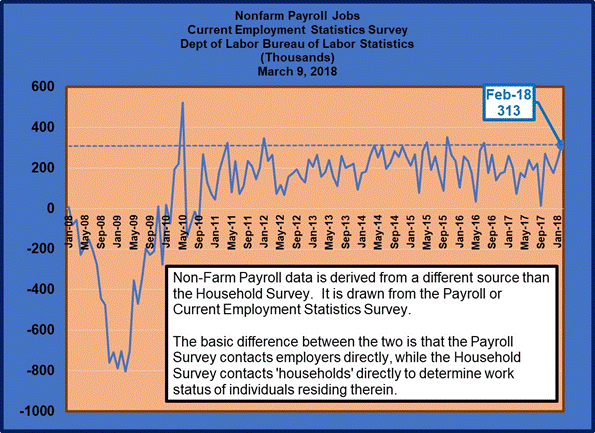
The most notable point in an overall excellent Employment Situation for February 2018 was the massive job growth for the month. This was a remarkable jobs report on many levels.
Looking into the Labor Force changes for the month of February 2018
First, the labor force grew by 806,000 for the month to 164,921,000. Drilling down, the growth in the labor force includes the employed (785,000) and the unemployed (22,000).
Next, the labor force participation rate is measured as the labor force [Employed + Unemployed] divided by the Civilian Noninstitutional Population. The Civilian Noninstitutional Population is equal to 256,934,000. The Labor Force (164,921,000) divided by the Civilian Noninstitutional Population (256.934,000) equaled 63.0%, up from 62.7% in January.
Again, for the month of February, 154,000 people were added to the Civilian Noninstitutional Population (those 16+ who are not in the military, in prison, or otherwise counted in institutions), while 806,000 were added to the Labor Force [employed plus unemployed]. This meant that an additional 653,000 moved from the sidelines and came back into the labor force.
To arrive at the Not in the Labor Force total you subtract the Labor Force 806,000 from the Civilian Noninstitutional Population 154,000 to arrive at 653,000 reduction in the Not in the Labor Force (note rounding 1,000).
To put this into perspective, while the labor force expanded by 806,000. only 22,000 were added to the ranks of the unemployed. The end result was that the U3 Unemployment Rate (those not employed, but actively seeking employment) remained static at 4.1%.
THE EMPLOYMENT SITUATION - FEBRUARY 2018
www.bls.gov/news.release/archives/empsit_03092018.pdf
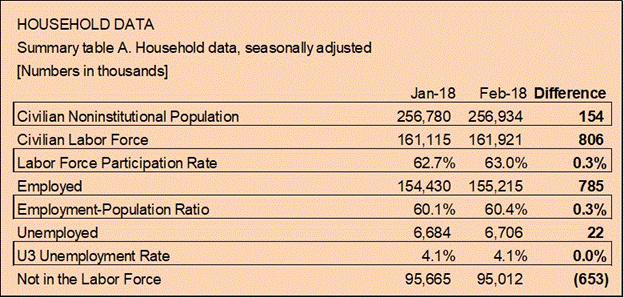
Excerpts from the February 2018 Household Data
The Civilian Noninstitutional Population grew by 154,000

The Civilian Labor Force (Employed + Unemployed) grew by 806,000

The Labor Force Participation Rate [Labor Force (Employed + Unemployed) / Civilian Noninstitutional Population] went from 62.7% in January to 63.0% in February

Employment expanded by 785,000 in February

Employment-Population Ratio (Employed / Civilian Noninstitutional Population) went from 60.1 in January to 60.4% in February.

Unemployed rose by 22,000

The U3 unemployment rate remained unchanged at 4.1%

563,000 people moved back into the ranks of the Labor Force (Employed + Unemployed) from the 'not in the labor force' segment of the Civilian Noninstitutional Population

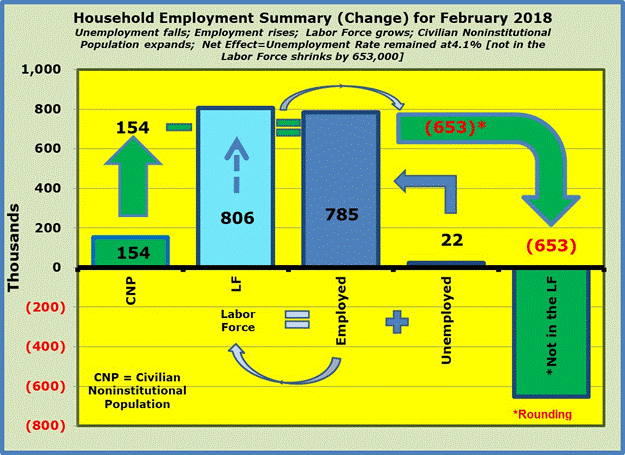
Referencing the preceding graphic, we start with the 'unemployed' increase of 22,000; added to an employed amount of 785,000; equaling a total expansion in the Labor Force of 806,000.
Moving on to Civilian Noninstitutional Population of 154,000, we subtract the Labor Force number of 806,000, leaving us with a total drop in the 'Not in the Labor Force' component of 653,000.
How does all of this relate to the significant drop in the Labor Force Participation Rate from before the Great Recession (December 2007 - June 2009)?
The Labor Force Participation Rate is calculated by combining those employed with those unemployed actively seeking employment and dividing that total by the Civilian Noninstitutional Population. Since early in 2008, when the Labor Force Participation Rate was above 66%, the LFPR has fallen precipitously and has not really gained that much traction. The last time it was above 63.0% was March 2014 when it came in at 63.1%.
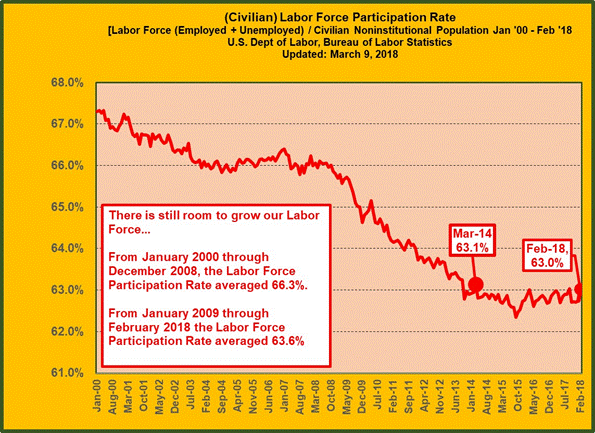
Simply put, conventional wisdom has pointed to the primary reason for the drop in the Labor Force Participation has been due to Baby-Boomers leaving the labor force - retiring. The Baby Boom birth years are generally considered to be 1946 through 1964. On the surface, this would seem fairly logical but if you break participation rate by age cohort (16-24; 25-34; 35-44; 45-54; 55-64; 65+), you find that the younger age groups' participation rates have fallen significantly. It is fairly obvious that if the economy was really expanding to the degree you would have expected following a recession, then job growth would have rebounded, especially with the younger age groups backfilling the jobs vacated by the retirees.

The Unemployment Rate - are we really at full employment level of unemployment?
The significance of what might be considered an artificially low U3 Unemployment Rate is that if the employment levels continue to rise, more people will be drawn back into the workforce that have been idle for a variety of reasons.
Let's be clear, a 4.1% U3 Unemployment Rate is quite low and would have indicated an economy at full employment historically. The situation we are encountering is that low Labor Force Participation is actually pointing to a large number of people - on the order of 7.7 million, are on the sidelines outside of the labor force. The term discouraged worker comes to mind describing a situation where individuals who would normally be considered unemployed have left the workforce entirely and no longer attached to the labor force due to the fact that they have given up any hope of finding employment.
The concern noted by the Federal Reserve (Federal Open Market Committee is that the low unemployment rate, coupled with an expanding economy will result in inflationary pressures mounting. Given the fact that there are likely on the order 7 or 8 million people - not counted in the unemployment numbers who would be interested in rejoining the labor force, this should alter the Fed's calculus in pushing for interest rate hikes (Federal Funds Target Rate).

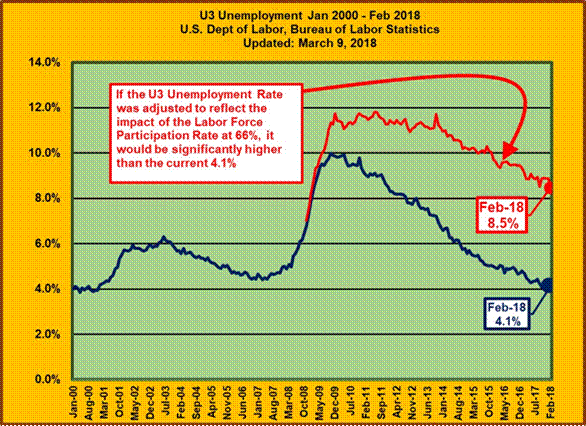
Is a return to a 66% Labor Force Participation Rate reasonable?
Our assertion that a significantly higher labor force participation rate is based on the fact that the younger age cohorts are still underperforming. If anything, the younger age groups should be employed at higher rates than had been the case in the past. Since the Baby-boomers are retiring (albeit at a lower rate than before the Great Recession), they are leaving behind positions that should likely be filled.
On a further note, when you consider that fact that it took until November 2014 to get back to the employment level of November 2007, and the population (Civilian Noninstitutional Population) continued to grow in a normal manner, it only makes sense that there was a good deal of slack in the labor markets. In addition to the Labor Force Participation Rate, we also focus on the Employment-Population Ratio which focuses on the relationship of Employment divided by the Civilian Noninstitutional Population. Similar to the Labor Force Participation Rate, the Employment-Population Ratio reflects a good deal of slack in the labor markets.
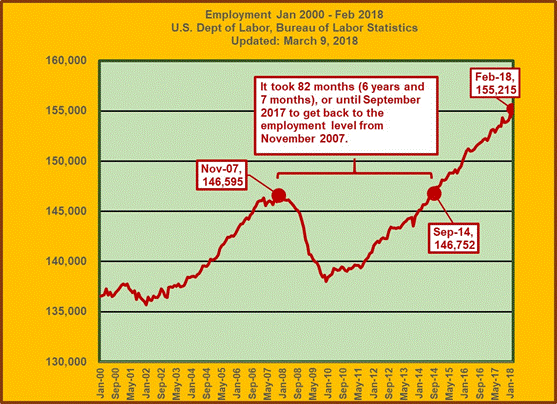
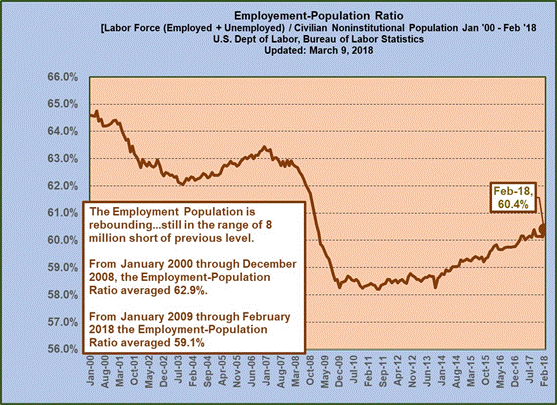
Summary - it's all about continued economic expansion
So long as this job growth continues, it doesn't matter if the unemployment rate ticks up (encouraged worker effect) due to the improved prospect of employment opportunities, or if those on the sidelines go directly into the ranks of the employed (steady unemployment rate). It all boils down to growing the economy at a rate sufficient to entice those on the sidelines to return to the ranks of the employed. All economic indicators are pointing to a continued economic rebound.
Repeat from previous article on
…a few last comments on the surveys from the monthly labor report
Background on the Current Population Survey (Household Survey)
The Current Population Survey is conducted by the U.S. Census Bureau for the Bureau of Labor Statistics. On a monthly basis, 60,000 households are surveyed and provide detailed information regarding individuals in that household sector:
- Civilian Noninstitutional Population (CNP) - 16+ years of age not in institutions (military, prison, etc.)
- Civilian Labor Force - those individuals from the CNP who are either employed or not employed but actively seeking employment (unemployed)
- Not in the Civilian Labor Force - those individuals in the CNP who are not part of the Labor Force [neither employed, nor actively seeking employment].
The survey itself is quite extensive, but we will focus on specific labor market issues including the Labor Force Participation Rate and the Employment-Population Ratio (Employed divided by the Civilian Noninstitutional Population)
Current Population Survey Questionnaire - Labor Force
(www2.census.gov/programs-surveys/cps/techdocs/questionnaires/Labor%20Force.pdf)
The Current Employment Statistics - CES (Establishment Survey/Payroll Survey)
For changes in jobs, the Bureau of Labor Statistics, along with the media in general, tend to point to the Payroll Survey/Report [Current Employment Statistics - CES (National)] which tallies up numbers drawn from surveys submitted by various entities - "Each month the Current Employment Statistics (CES) program surveys approximately 144,000 businesses and government agencies, representing approximately 554,000 individual worksites, in order to provide detailed industry data on employment, hours, and earnings of workers on nonfarm payrolls."http://www.bls.gov/ces/


